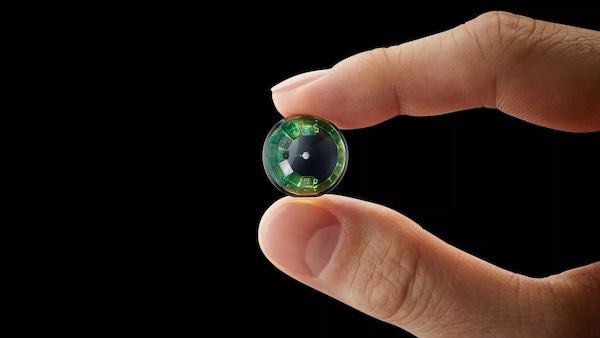Your Friday ROV Footage of Deep-Sea Denizens
Rock could have beat him if he came at him with scissors instead of paper.
— J. Elvis Weinstein (@JElvisWeinstein) March 28, 2022
A Lamp Unto Their Feet
Core77 rightly points out that, even as parts of Ukraine are under attack, in other parts of the besieged country, factories and other manufacturing facilities need to keep operating in order to generate the revenue needed to pay its employees. Linedock, for example, is a consumer electronics manufacturer with facilities in western Ukraine—a scant 200 miles from the nearest combat zone.
For the survival of Ukraine, it’s important to keep the flow of cash coming into the country. Thus Linedock has launched the Robinwood Project, an initiative whereby the purchase of a Ukraine-designed, Ukraine-sourced product will see all of the profits donated to NGOs in-country and on the ground. The first object they’re offering is the Storm Lamp, by Ukrainian industrial designer Julia Kononenko. It’s made from laser-cut plywood sourced from the region.

Linedock will done to the following NGOs:
- Humanitarian Aid and Medical Supply: Vostok-SOS
- Food Supply: World Central Kitchen
- Childcare: Voices of Children
- Protection of civilians and army (non-lethal): KOLO
The lamp can be purchased here. “Proceeds from this Storm Lamp help sustaining employment in unimpacted areas in Ukraine. All profits are donated to NGO's active on the ground.”
Infinite Possibilities
It doesn’t have an infinite wine cellar. Unless it contains an eternal Kerr black hole, although even then it wouldn’t be a very good wine cellar because you couldn’t get the wine out, at least into our Universe. https://t.co/v2wsV1kCCO
— Brian Cox (@ProfBrianCox) March 29, 2022
Image 360
Do you like pop-up books? A 360-degree field of vision? If so, good news! Via Core77, architect Yusuke Oono“designed a new platform of expressing story, or a three-dimensional visual scene.” That is, he used CAD software and a laser cutter to create visually dense, 360-degree pop-up storybooks.


Still images don’t do Oono’s work justice, so check out this very cool video:
Oono’s books are available on Amazon.
Blanking Out
In support of the 1880 Garfield-Arthur ticket, the Republican Party published this “Record of the Statesmanship & Political Achievements” of Democratic presidential candidate Gen. Winfield Scott Hancock. It contained only blank pages.
— James A. Garfield National Historic Site (@GarfieldNPS) March 26, 2022
19th century political snark is timeless. pic.twitter.com/VxHwOytqOz
The Eyes Have It
While everyone is beavering away trying to perfect a system for using eyeglasses as a display screen for mobile devices, one company has already started going to the next level: using contact lenses as a data display device. From Axios: Saratoga, Calif.-based Mojo Vision announced that it is “close to having a working prototype of a contact lens capable of showing basic information such as driving directions using only eye movements to control the display.”
How it works: A monochrome green display and a handful of sensors are built into a rigid lens, similar to modern hard contacts.
The computing work, meanwhile, is handled by a nearby neck-worn computer that can be hidden under a shirt and communicates using a proprietary wireless technology. Even low-energy Bluetooth uses too much power.
Mojo packs a lot of technology into the lens, including a tiny processor, microLED display and battery as well as the sensors needed to detect eye movement.

Image: Mojo Vision
Eventually, Mojo aims to sell to athletes and others who might benefit from instant, heads-up access to information — ultimately, even mainstream consumers.
But initially, the firm is focusing on those who have low vision thanks to conditions like retinitis pigmentosa.
Don’t Cut the Cords
Last month I did the unthinkable and finally threw out that box of unloved cables that I've dragged with me through adulthood.
— Lemuel Lyes (@LemuelLyes) March 28, 2022
Today I realised that I needed one of them and have no idea how to find a replacement.
CONSIDER THIS A WARNING TO YOU ALL
Contact-Free Based Delivery
We have seen, as it were, the future of eye care and it includes contact lens-based medication delivery. Says Gizmodo:
The Food and Drug Administration has approved a new type of contact that releases an antihistamine to help prevent itchy eyes from allergies for up to 12 hours. Similar treatments for other eye diseases may be on the way soon.
… In clinical trials, the Theravision lens performed better than a placebo lens and reliably relieved itchy eyes in as little as three minutes, while working for as long as 12 hours. Because it’s also a corrective lens, people can wear it to help with their eyesight as they would any other daily disposable contact.
Add in a digital display, and the lens can tell you what it is dispensing
Oh, Deer
I will never not laugh at this pic.twitter.com/l7081waQyy
— Eric Alper ?? (@ThatEricAlper) March 28, 2022
CO Mingling
Was it a good week for graphene news? It’s always a good week for graphene news! From Graphene-Info: Researchers have found a way to use carbon monoxide (CO) to synthesize high-quality graphene. Essentially, graphene needs a carbon source, and using CO has its advantages.
The technique is said to be a fast and cheap way to produce high-quality graphene with relatively simple equipment for use in electronic circuits, gas sensors, optics, and more.
…“The system we used has a number of advantages: The resulting graphene is purer, grows faster, and forms better crystals. Moreover, this tweak prevents accidents with hydrogen and other explosive gases by eliminating them from the process altogether,” says the study’s first author, Skoltech intern Artem Grebenko.
The fact that the method rules out combustion risks means that no vacuum is required. The apparatus works at standard pressure, making it much simpler than conventional CVD equipment. The simplified design, in turn, leads to faster synthesis. “It only takes 30 minutes from taking a bare piece of copper to pulling out the graphene,” Grebenko says.
Since vacuum is no longer needed, the equipment not just works faster but also becomes cheaper. “Once you drop the high-end hardware for generating ultrahigh vacuum, you can actually assemble our ‘garage solution’ for no more than $1,000,” the researcher stresses.
Indeed
I work for a bank call center. I absolutely try to make your life harder if you yell at me for things I can't control.
— Fesshole ?? (@fesshole) March 14, 2022
Ears, Nose, and Throat
We are intimately aware that today is April Fool’s Day, but this announcement from Dyson is no joke: yes, it is a combination air purifier/headphones. You have just entered…the Dyson Zone.
The Dyson Zone™ is a set of noise cancelling, high fidelity over-ear headphones which simultaneously deliver immersive sound to the ears, and purified airflow to the nose and mouth. The result of over a decade of air quality research and development, the Dyson Zone™ air-purifying headphones simultaneously tackle the urban issues of air quality and noise pollution.
Add a VR headset and you can remove yourself completely from reality, which doesn’t sound like a bad idea.

Dyson
Odd Phrase
who came up with the term human resources, aliens?
— Myka Fox ?? (@MykaFox) March 21, 2022
Chip Off the Old Blockhead
Elon Musk’s company Neuralink, founded six years ago, has been working on an implantable brain chip that will give humans the ability to achieve some kind of “symbiosis” with electronic devices. If your response to that is, “What could possibly go wrong?” well, you are not alone. Via Gizmodo, more than three-fourths (78%) of U.S. adults surveyed in a Pew Research report said they “would not personally want an IQ-enhancing brain chip implant even if they were available.” Only 13% thought that these kinds of brain implants would be good for society at large, while more than one-half (56%) thought they would be bad.
Over half (57%) worried the widespread use of these types of brain interfaces could potentially widen the already gaping distance between high and low-income Americans. And even if these Cyberpunk-esque features do eventually make their way to market, only slightly less than a quarter of respondents think all that new processing power will actually improve human decision making.
However, people in general are more sanguine about the use of some kind of man–machine interface to address medical conditions. “A large majority of respondents (77%) said they would support brain implants when used in medical applications like increasing movement for paralyzed people.”
A Quantum of Solace
When the condiment bottle looks full but you can't be sure until you open it: Schrödinger's catsup.
— Michael McKean (@MJMcKean) March 12, 2022
Then Again…
Via Boing Boing:
In a recent study published by Nature Communications, scientists from the Wyss Center for Bio and Neuroengineering in Geneva, Switzerland shared remarkable new details about a human being using a brain-computer interface to ask if he can have a beer and listen to TOOL.
The patient in question is a 36-year-old man who, due to amyotrophic lateral sclerosis (ALS), has been in a “completely locked-in state” for several years—a state that includes the muscles in his eyes. Where previous brain interface experiments have in fact used implants in places such as the eyes, that was not an option in this case.
This participant was implanted with intracortical microelectrode arrays in two motor cortex areas. The patient, who is in home care, then employed an auditory-guided neurofeedback-based strategy to modulate neural firing rates to select letters and to form words and sentences using custom software. Before implantation, this person was unable to express his needs and wishes through non-invasive methods, including eye-tracking, visual categorization of eye-movements, or an eye movement-based BCI-system.
(Autocorrect insists on trying to change “implant” to “inplant,” which would be a whole other experiment entirely.)
OoO, Dear
This hits home: pic.twitter.com/49VSsWnRjJ
— David Gallaher (@DavidGallaher) March 28, 2022
Mensch-Maschine
Then again, there is some sense in which this kind of man–machine hybrid already exists, the emblematic example being the German band Kraftwerk, who, on their 1978 album Man Machine, proclaimed, “We are the robots!” Kraftwerk is perhaps the most well-known of a genre of music that emerged in Germany the 1960s and 70s known as “Krautrock” (Neu!, Can, and Amon Düul were other prominent Krautrock bands). Like just about any other musical genre, Krautrock had its own visual style that graphic artists used for concert posters and other display materials.
If you’re in Berlin before April 24, be sure to stop by the Bröhan Museum and check out its “Krautrock Posters” exhibition.
The 40 posters on display span the scene’s roots in the counterculture moment of 1968, where some bands were mere support acts for earnest political debates; to the more playful reflections on national cultural identity of the late 70s and early 80s. In a poster for a 1975 Kraftwerk concert, the road to the future is a German autobahn populated by Volkswagen Beetles.
Krautrock was a musical rebellion of sorts, first against “schlager,” which was itself a post-war reaction against American rock’n’roll, and then against American jazz and English beat rock bands, which had taken over much of the world by the late 1960s.
… If Krautrock was a revolution, however, it also passed much of Germany by at the time, and was quickly semi-forgotten. The Bröhan show is the first exhibition in the country dedicated specifically to a German underground music scene that was first recognised as a coherent movement by the British music press.

Composite: Bröhan Museum
Adulthood
Being an adult is saying to yourself "once I get this week out of the way I'll be less stressed" FOR THE REST OF YOUR LIFE.
— Nathalie Antonia (@natsantonia) March 28, 2022
Automat On
 Visitors to New York City used to have fond memories of “dining” at the automat, a self-service fast-food restaurant where meals were purchased via vending machines. The most famous automat was perhaps New York’s (at one time there were 40 automats throughout the city), but the concept was actually invented in Berlin, Germany, in 1895, and the first U.S. automat opened in Philadelphia in 1902 by Horn & Hardart, which became the biggest American automat chain. In the 1940s, 50, and 60s, the automat had its fans—Walter Winchell, Irving Berlin, and other celebrities of the time were patrons—and New York automats were also popular among struggling songwriters and actors. In the 1950s, the rise of fast food restaurants threatened the automat model (there was more personalized service and more flexible payment options than putting a coin in a slot), and by the 1970s inflation drove up food prices (Really? Such a thing can happen?) and in an era before vending machines accepted bills, you would need a lot of coins for an automat meal. Plus, there was also the sense that the food quality had gone down. By the time of its ultimate demise, the automat was little more than a nostalgia trip. The last one closed in 1991, and Horn and Hardart converted most of its New York City automats to Burger Kings. So it goes. We suppose that’s progress.
Visitors to New York City used to have fond memories of “dining” at the automat, a self-service fast-food restaurant where meals were purchased via vending machines. The most famous automat was perhaps New York’s (at one time there were 40 automats throughout the city), but the concept was actually invented in Berlin, Germany, in 1895, and the first U.S. automat opened in Philadelphia in 1902 by Horn & Hardart, which became the biggest American automat chain. In the 1940s, 50, and 60s, the automat had its fans—Walter Winchell, Irving Berlin, and other celebrities of the time were patrons—and New York automats were also popular among struggling songwriters and actors. In the 1950s, the rise of fast food restaurants threatened the automat model (there was more personalized service and more flexible payment options than putting a coin in a slot), and by the 1970s inflation drove up food prices (Really? Such a thing can happen?) and in an era before vending machines accepted bills, you would need a lot of coins for an automat meal. Plus, there was also the sense that the food quality had gone down. By the time of its ultimate demise, the automat was little more than a nostalgia trip. The last one closed in 1991, and Horn and Hardart converted most of its New York City automats to Burger Kings. So it goes. We suppose that’s progress.
At any rate, for those who may be nostalgic, or curious as to what anyone would be nostalgic for, there is a new documentary out called The Automat, featuring Mel Brooks. It is currently being screened in theaters and virtually. Check out screening dates and locations here.
Unhinged
Office Workers Terrorized By Unhinged Ex-Employee Dropping In To Say Hi https://t.co/rwvHZqnz6C pic.twitter.com/6ow3pWOadj
— The Onion (@TheOnion) March 24, 2022
Blocked!
The phrase “LEGO-related injury” may not be a common one, but the phenomenon itself certainly is. Matty Benedetto, host of the YouTube channel Unnecessary Inventions, has himself been waging an invention-based war against accidental block maiming (including special socks that act as a kind of LEGO-proof armor for the feet). His latest sortie is a LEGO vacuum that not only sucks up LEGO from floors and carpets, but also sorts them. Via AV Club:
Benedetto modifies a Shop-Vac by designing and 3D printing four canister inserts that filter Lego pieces by size as they’re sucked up. He uses a transparent canister and improves the airflow so Lego blocks easily get grabbed up by the vacuum and move through the sorting layers with enough suction to get properly sorted.
The Lego vacuum (or, we suppose, the Lego Suck It) performs admirably when demonstrated at the end of the video. A montage shows Benedetto running the tube around a carpet, easily sucking up Lego bricks so they’re sorted into the appropriate layers of the canister. Not only does it work as intended, but the cleaning process is unexpectedly hypnotic to watch.
There should be a Nobel Prize for this kind of thing.
Confusion
The rare headline that could indicate either a rave or a pan. https://t.co/73ko8sdLv6
— (((Joshua Malina))) (@JoshMalina) March 27, 2022
Valhalla, I Am Coming
Finally we leave you to the rest of today’s April Foolery with this cover of Led Zeppelin’s “The Immigrant Song” performed by a squeaky rubber chicken.
Know Your Magazines
I’m “People Smart.” I’m also “Us Weekly Smart.” https://t.co/rJdPaEquTu
— (((Joshua Malina))) (@JoshMalina) March 30, 2022
This Week in Printing, Publishing, and Media History
March 28
1836: German-American brewer and founder of the Pabst Brewing Company Frederick Pabst born. (Did they sponsor the hipster Olympics?)
1842: First concert of the Vienna Philharmonic Orchestra, conducted by Otto Nicolai.
1868: Russian novelist, short story writer, and playwright Maxim Gorky born.
1994: How absurd: Romanian-French playwright and critic Eugène Ionesco dies (b. 1909).
March 29
1871: Royal Albert Hall is opened by Queen Victoria.
1886: John Pemberton brews the first batch of Coca-Cola in a backyard in Atlanta.
1943: English actor and comedian Eric Idle born, looking on the bright side of life.
1999: The Dow Jones Industrial Average closes above the 10,000 mark (10,006.78) for the first time, during the height of the dot-com bubble.
March 30
1853: Dutch-French painter and illustrator Vincent van Gogh born.
1880: Irish dramatist, playwright, and memoirist Seán O'Casey born.
1986: American poet and etymologist John Ciardi dies (b. 1916).
2004: English-American journalist and author Alistair Cooke dies (b. 1908).
March 31
1596: French mathematician and philosopher René Descartes born. (Apparently he thought.)
1631: English lawyer and poet John Donne dies (b. 1572).
1685: German organist and composer Johann Sebastian Bach born.
1732: Austrian pianist and composer Joseph Haydn born.
1809: Ukrainian-Russian short story writer, novelist, and playwright Nikolai Gogol born.
1855: English novelist and poet Charlotte Brontë dies (b. 1816).
1889: The Eiffel Tower is officially opened. (Not everyone in France was a fan; author Guy de Maupassant ate lunch every day at the tower’s base restaurant, because, he said, “inside the restaurant was one of the few places where I could sit and not actually see the Tower!”)
1906: The Intercollegiate Athletic Association of the United States (later the National Collegiate Athletic Association) is established to set rules for college sports in the United States. (Before that it was all just madness...)
1918: Daylight saving time goes into effect in the United States for the first time and, unfortunately, not the last.
1930: The Motion Picture Production Code is instituted, imposing strict guidelines on the treatment of sex, crime, religion and violence in film, in the U.S., for the next 38 years.
1951: Remington Rand delivers the first UNIVAC I computer to the United States Census Bureau. (And they’re still using it today.)
2016: Scottish comedian, actor and screenwriter Ronnie Corbett dies (b. 1930).
April 1
1854: Charles Dickens’ novel Hard Times begins serialization in his magazine Household Words.
1960: The TIROS-1 satellite transmits the first television picture from space.
1976: Apple Inc. is formed by Steve Jobs, Steve Wozniak, and Ronald Wayne in Cupertino, Calif.
2004: Google announces Gmail to the public.
April 2
1800: Ludwig van Beethoven leads the premiere of his First Symphony in Vienna.
1805: Danish novelist, short story writer, and poet Hans Christian Andersen born.
1840: French novelist, playwright, journalist Émile Zola born.
1872: American painter and academic, inventor of the telegraph and Morse code Samuel Morse dies (b. 1791).
1902: “Electric Theatre,” the first full-time movie theater in the United States, opens in Los Angeles.
1941: American radio host Dr. Demento born.
1956: As the World Turns and The Edge of Night premiere on CBS. The two soaps become the first daytime dramas to debut in the 30-minute format.
1973: Launch of the LexisNexis computerized legal research service.
April 3
1783: American short story writer, essayist, biographer, historian Washington Irving born.
1774: Irish novelist, playwright and poet Oliver Goldsmith dies (b. 1728).
1860: The first successful United States Pony Express run from St. Joseph, Mo., to Sacramento, Calif., begins.
1895: The trial in the libel case brought by Oscar Wilde begins, eventually resulting in his imprisonment on charges of homosexuality.
1898: American publisher, and co-founder of Time Magazine Henry Luce born.
1949: English singer-songwriter and guitarist Richard Thompson born.
1955: The American Civil Liberties Union announces it will defend Allen Ginsberg's book Howl against obscenity charges.
1973: Martin Cooper of Motorola makes the first handheld mobile phone call to Joel S. Engel of Bell Labs.
1981: The Osborne 1, the first successful portable computer, is unveiled at the West Coast Computer Faire in San Francisco.
2010: Apple Inc. released the first generation iPad, a tablet computer.















Discussion
Only verified members can comment.